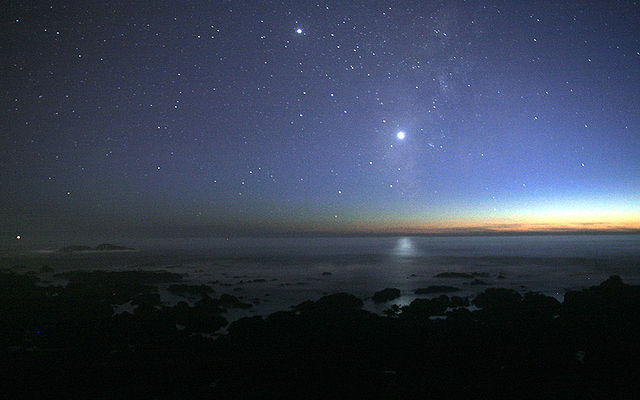Observations and explorations of Venus
Observations of the planet Venus include those in antiquity, telescopic observations, and from visiting spacecraft. Spacecraft have performed various flybys, orbits, and landings on Venus, including balloon probes that floated in the atmosphere of Venus. Study of the planet is aided by its relatively close proximity to the Earth, compared to other planets, but the surface of Venus is obscured by an atmosphere opaque to visible light.
Venus in real colors, processed from clear and blue filtered Mariner 10 images.
Venus is always brighter than the brightest stars outside the Solar System, as can be seen here over the Pacific Ocean
Phases of Venus and evolution of its apparent diameter
The Pre-Columbian Mayan Dresden Codex, which calculates appearances of Venus.
The atmosphere of Venus is the very dense layer of gasses surrounding the planet Venus. Venus's atmosphere is composed of 96.5% carbon dioxide and 3.5% nitrogen, with other chemical compounds present only in trace amounts. It is much denser and hotter than that of Earth; the temperature at the surface is 740 K, and the pressure is 93 bar (1,350 psi), roughly the pressure found 900 m (3,000 ft) under water on Earth. The atmosphere of Venus supports decks of opaque clouds of sulfuric acid that cover the entire planet, making optical Earth-based and orbital observation of the surface impossible. Information about surface topography has been obtained exclusively by radar imaging.
1761 drawing by Mikhail Lomonosov in his work on the discovery of atmosphere of Venus
Composite image of the polar vortex of Venus in strong red (red image is an infrared view of hot high clouds and the grey image is an ultra-violet view of lower clouds)
Meridional (north-south) component of the atmospheric circulation in the atmosphere of Venus. Note that the meridional circulation is much lower than the zonal circulation, which transports heat between the day and night sides of the planet
False colour near-infrared (2.3 μm) image of the deep atmosphere of Venus obtained by Galileo, red areas are signatures of the hot surface radiating through the atmosphere relatively unhindered. The dark spots are clouds silhouetted against the very hot lower atmosphere emitting thermal infrared radiation.








